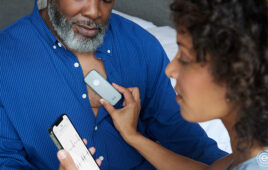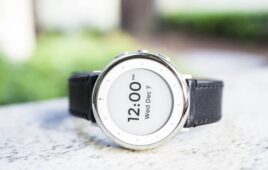Electronic anti-theft systems still post a threat to cardiac device patients, according to research presented this week at a symposium in Nice, France.
“Cardiac implantable electronic devices (CIEDs) are critical to patients’ health,” said co-author Dr. Rod Gimbel, an electrophysiologist at Cleveland’s Case Western Reserve University. “Pacemakers provide pacing support, without which there would be no heart beat at all for a pacemaker dependent patient. Implantable cardioverter defibrillators (ICDs) deliver pacing or shocks to rescue patients from potentially life threatening arrhythmias.”
Even though reported events are rare, prolonged exposure to electronic anti-theft systems, also called electronic article surveillance (EAS) systems, can cause pacing therapy to drop beats or in the worst case leave pacemaker dependent patients with no heart beat, and cause ICDs to deliver inappropriate shocks.
In 2000 the U.S. Food and Drug Administration (FDA) advised CIED patients not to linger or lean next to EAS systems. But since then manufacturers have created sleeves for retailers to cover traditional pedestal systems with advertising and new systems are hidden under floors, in walls and in doors.
“We tell patients ‘don’t linger, don’t lean’ but that advice is hard to follow when systems are invisible,” Gimbel said. “To make matters worse, advertising draws patients closer to the pedestals. Some shops have placed camouflaged pedestals next to a chair or in a checkout line, so patients may be next to them for some time, and sofas are put on top of under floor systems, encouraging patients to sit for long periods.”
The current study was conducted at Georgia Tech Research Institute in Atlanta and assessed the safety of modern EAS systems. The investigators tested pacemakers and ICDs with up to five CIED manufacturers against the three types of EAS systems currently in use: Pedestals (five manufacturers), door frames/in wall (two manufacturers) and under floor (two manufacturers).
The under floor system was tested flat and at a 30 degree angle to mimic slouching in a chair. The results were recorded in four categories: No interference, prolonged pacemaker inhibition, inappropriate shocks, and other inappropriate tachycardia therapy such as anti-tachycardia pacing or subclinical shocks.
The tests were conducted with the pacemakers and ICDs in a tank filled with a type of saline that mimics the electric properties of body tissue. Cardiac device leads were placed in the same loop shape as they would be in a patient and the devices were tested in unipolar and bipolar settings.
The distance between devices and the floor was set for average height patient. Devices were tested in static positions and using a robot to simulate a patient walking through the EAS systems, leaning towards them, and facing them.
The investigators found that the pedestal systems interfered with cardiac device functioning particularly when the devices were in close proximity and lingered. Devices programmed for unipolar sensing had the most interactions which included prolonged inhibition of pacing and inappropriate ICD therapy. Devices programmed with bipolar sensing showed fewer interactions but unintentional shocks and other inappropriate tachycardia therapy was observed.
“Significant interactions occurred with nearly all the pacemakers and ICDs when the robot closely faced the EAS system and the device lead loop was parallel to the EAS system loop,” Robert Stevenson, senior scientist at Greatbatch Medical in Santa Clarita, CA, said. “Facing or having your back to an EAS pedestal or a toddler with a pacemaker crawling over a subfloor system is of particular concern.” Stevenson presented the research at the Nice symposium, CARDIOSTIM – EHRA EUROPACE 2016.
Wall (door frame) systems did not interfere. Preliminary tests of under floor systems (only two CIED manufacturers), which are completely hidden, did not interfere when flat or at a 30 degree angle from vertical.
“We know from the physics that at 90 degrees (this is when the patient’s chest is close and parallel to the floor) we would likely have serious interactions,” Stevenson said. “Further testing is needed to find out when the angle becomes dangerous. I suspect it will be about 45 degrees. This angle could occur with a patient really slouching in a chair for example.”
He added that unipolar sensing is sometimes required but urged doctors to use bipolar sensing since the lead loop area is smaller, lowering the chance of interference.
“Patients are safe if they walk at a constant pace through the system,” Stevenson said in concluding remarks. “EAS gates that are obscured with advertising or goods for sale, or hidden in the floor with couches or chairs adjacent, are a serious concern and EAS manufacturers have a responsibility to ensure that retailers install them in such a way that they are visible and well marked.”




